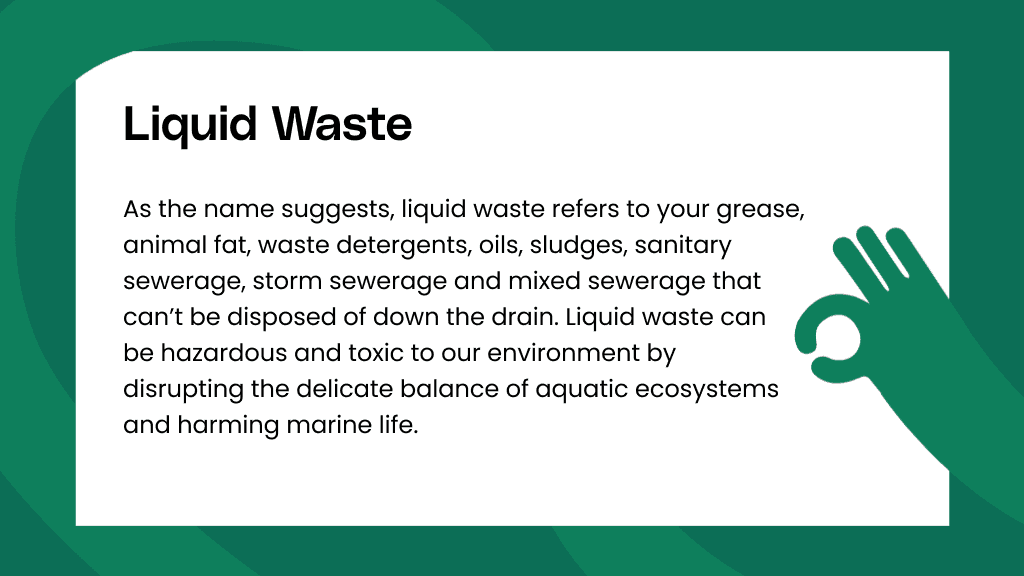The 6-Minute Rule for Reclaim Waste
The 6-Minute Rule for Reclaim Waste
Blog Article
Reclaim Waste Can Be Fun For Everyone
Table of ContentsLittle Known Facts About Reclaim Waste.Unknown Facts About Reclaim WasteUnknown Facts About Reclaim WasteThe Ultimate Guide To Reclaim WasteReclaim Waste Fundamentals Explained
Residential sewer waste refers to the waste and items from a household septic container. The appropriate monitoring and disposal of domestic sewage waste need fluid waste to be moved to a sewer therapy plant where the proper methods and equipment are used to detoxify and dispose of waste.
Industrial waste frequently includes possible dangers, such as flammable materials or a blend of fluid and solid waste products, and requires an advanced and comprehensive disposal process. The disposal of commercial waste commonly entails the filtration of waste before transport to ensure risk-free and correct disposal. Industrial waste is created from by-products and drainage of commercial processes and production.
This type of waste can not make use of the exact same sewer administration transportation or procedures as septic or commercial liquids. The hazardous waste management procedure needs the assessment and screening of liquid waste prior to it undertakes the disposal procedure (liquid waste removal). Runoff waste is the fluid waste that originates from drainage and excess stormwater in highly inhabited areas or cities
Overflow waste can create contamination and flooding otherwise managed properly. Discover more about sewage system cleansing and waste management. Guaranteeing correct waste monitoring can prevent calamities and minimize environmental damage. Both individuals in residential settings and experts in industrial or manufacturing sectors can take advantage of comprehending the procedures and regulations of fluid waste management.
The 2-Minute Rule for Reclaim Waste
Contact PROS Solutions today to discover our waste monitoring and disposal services and the appropriate ways to look after the liquid waste you create.
(https://www.tumblr.com/reclaimwaste1/766851148823068673/at-reclaim-waste-were-a-national-solutions?source=share)Do you know what takes place to your water when you draw the plug, flush the commode or drain the washing equipment? No? Well, it's worth knowing. This supposed 'wastewater' is not only a crucial resource yet, after treatment, will certainly be released to our land, rivers or the ocean. Made use of water from bathrooms, showers, baths, kitchen area sinks, laundries and commercial processes is recognized as wastewater.

water used to cool equipment or clean plant and equipment). Stormwater, a kind of wastewater, is overflow that flows from farming and urban areas such as roofing systems, parks, yards, roads, courses and seamless gutters into stormwater drains pipes, after rainfall. Stormwater flows untreated straight to neighborhood creeks or rivers, ultimately getting to the ocean.
Reclaim Waste for Beginners
In Queensland, most wastewater is treated at sewage treatment plants. Wastewater is carried from residential or industrial sites through a system of sewers and pump stations, recognized as sewage reticulation, to a sewage treatment plant.
The Department of Natural Resources suggests city governments concerning handling, operating and preserving sewerage systems and treatment plants. In unsewered locations, neighborhood federal governments may call for homeowners to mount individual or family sewer therapy systems to deal with residential wastewater from toilets, cooking areas, washrooms and washings. The Department of Natural Resources authorizes making use of house systems when they are shown to be efficient.
A lot of stormwater receives no treatment. In some new class, treatment of some stormwater to get rid of clutter, sand and gravel has actually started utilizing gross pollutant catches. Wastewater treatment takes place in four phases: Removes strong matter. Bigger solids, such as plastics and various other objects mistakenly discharged to sewers, are gotten rid of when wastewater is passed with screens.
Wastewater then moves into big tanks where solids clear up and are gotten rid of as sludge. Grease and residue are skimmed from the surface. Utilizes little living organisms referred to as micro-organisms to damage down and remove continuing to be dissolved wastes and fine fragments. Micro-organisms and wastes are incorporated in the sludge. Eliminates nitrogen and phosphorus nutrients that can cause algal blooms in our rivers and intimidate aquatic life.
Our Reclaim Waste Ideas
Nutrient elimination is not available in any way sewer therapy plants because it requires costly specialized tools. It is coming to be a lot more common in Queensland. Clear liquid effluent produced after treatment may still include disease-causing micro-organisms. If this effluent is released into waterways such as rivers or the sea, the micro-organisms will ultimately die out.

A lot of wastewater streams visit here right into the sewerage system. Under the Act, neighborhood federal governments administer authorizations and licences for eco appropriate activities (ERAs) entailing wastewater releases that may have a neighborhood influence.
The Of Reclaim Waste
Tracking supplies accurate info concerning water top quality and can validate that permit problems are being fulfilled. The information acquired with tracking gives the basis for making water top quality decisions.
Report this page